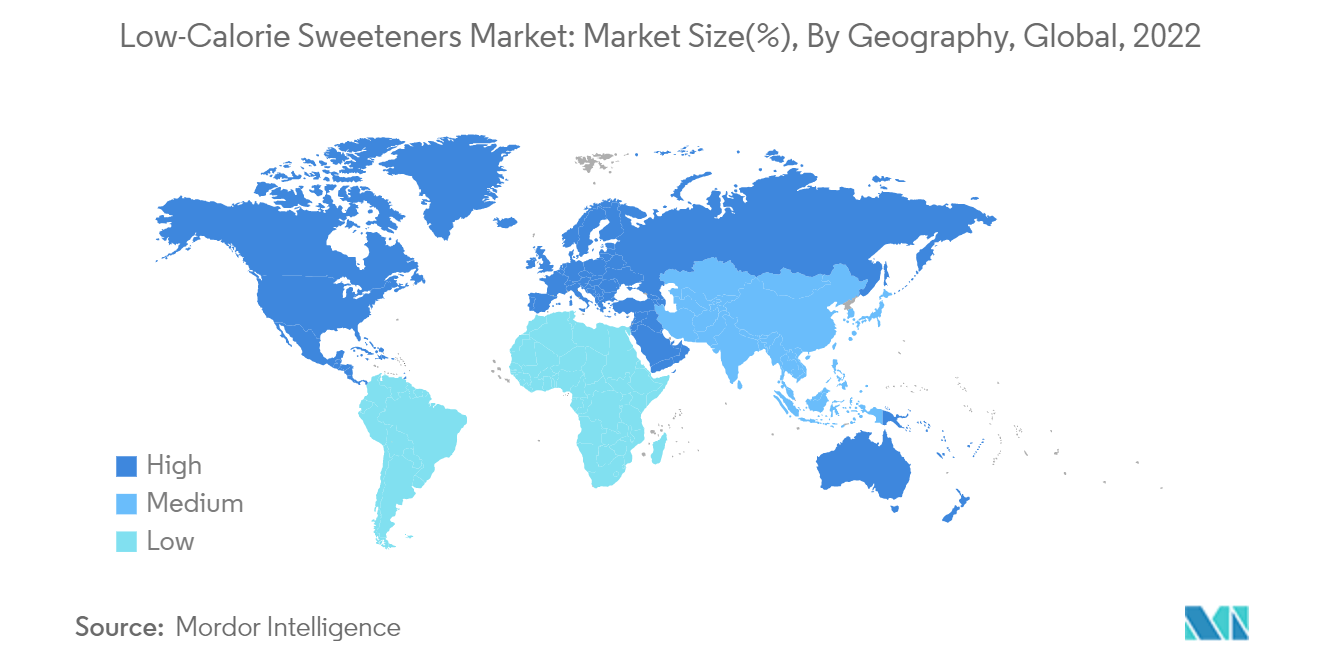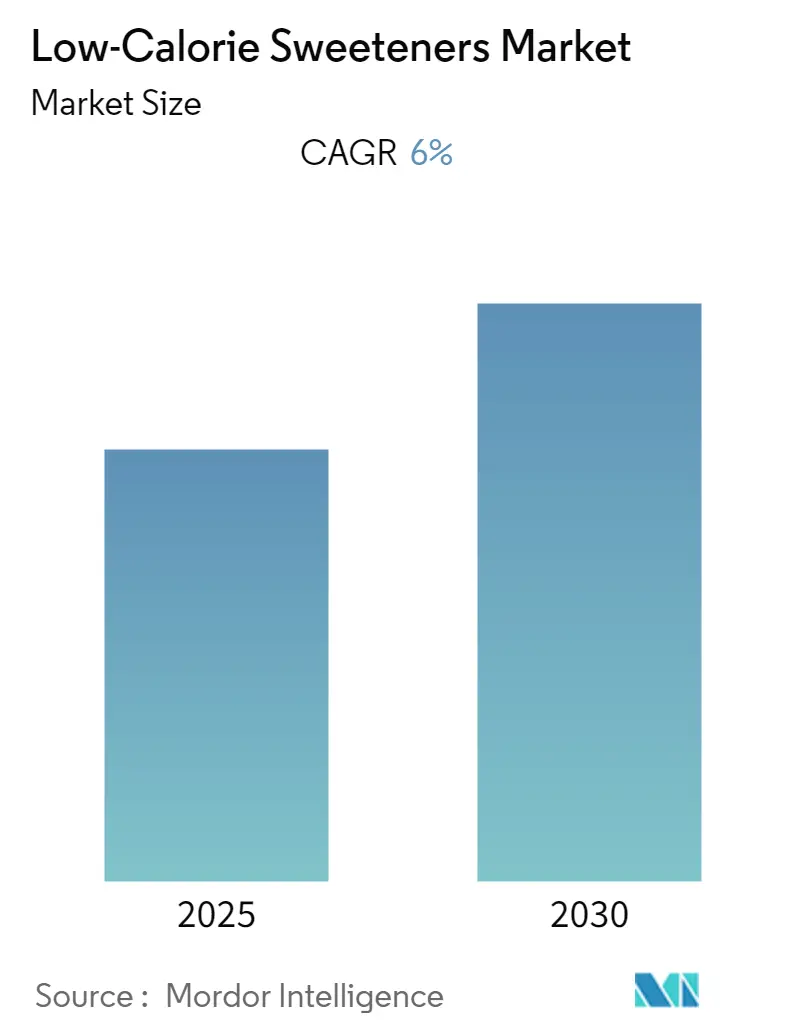
| Study Period | 2019 - 2030 |
| Base Year For Estimation | 2024 |
| Forecast Data Period | 2025 - 2030 |
| CAGR | 6.00 % |
| Fastest Growing Market | Asia-Pacific |
| Largest Market | Europe |
| Market Concentration | Medium |
Major Players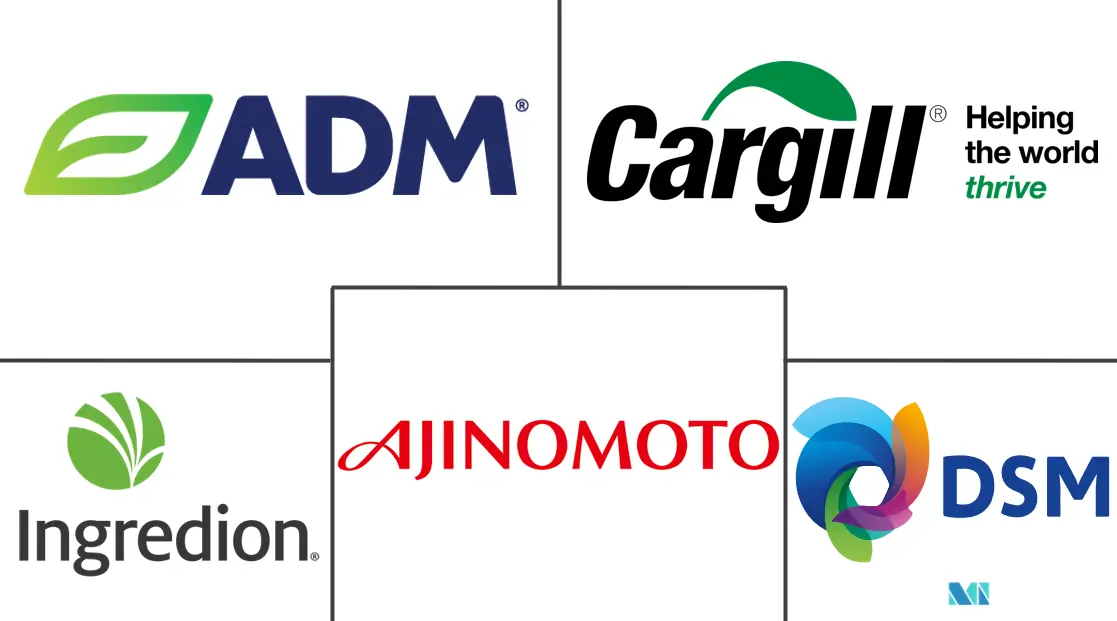
*Disclaimer: Major Players sorted in no particular order |
Low-Calorie Sweeteners Market Analysis
The Low-Calorie Sweeteners Market is expected to register a CAGR of 6% during the forecast period.
Sugar reduction practice has become a common trend among consumers focusing on their dietary shift leading to general wellness and health. Reducing sugar has become a top health priority, particularly among consumers looking to manage their weight. This is increasing the demand for low-calorie sweeteners in the market. Thus, manufacturers are focusing on offering low-calorie sweeteners; for instance, in April 2021, Cargill and DSM launched Eversweet, a non-artificial, zero-calorie sweetener, through its joint venture Avansya which offers natural and healthy sweetening solutions. Moreover, in 2018, FDA approved saccharin sweeteners for use in food across the United States as non-nutritive sweeteners that include brands such as Sweet and Low, Sweet Twin, Sweet'N Low, and Necta Sweet. This benefited the US low-calorie sweeteners market, and exporters around the world are targeting the market.
There is high consumption of beverages with added sugar among American consumers, giving rise to health problems including obesity, diabetes, and heart diseases. Moreover, according to the International Diabetes Federation 2021, the North American and Caribbean regions had a large number of children and adolescents with type 1 diabetes, with around 193,000 in total. Thus, owing to growing diabetic consumers in the region, low-calorie sweeteners are expected to see significant growth over the forecast period.
Low-Calorie Sweeteners Market Trends
Health-conscious Consumers Reducing Sugar Content in their Food
Consumers have a growing health consciousness due to increasing awareness of immune and rising health problems. The rate of obesity has grown drastically among adults along with young children in most developed countries. Obesity is associated with adverse health conditions, including diabetes and cardiovascular diseases. The high-calorie consumption consciousness among American consumers is driving the demand for low-calorie foods and beverages across the country. In addition, according to the 2nd Annual Advancing Sugar Reduction Technologies Summit in 2021, around 84% of consumers were reducing sugar consumption, and over 56% of consumers are focusing on consuming less sugar. This is increasing the market flow of low-calorie food and beverage products from manufacturers to meet the growing consumer demands.
Moreover, authorities like the WHO are also contributing to the growth of low-calorie sweeteners; for instance, new WHO guidelines recommend consumers reduce their daily intake of sugar to less than 10% of their total energy intake. Thus, the growing health consciousness among consumers is expected to benefit the global low-calorie sweeteners market. Furthermore, major players in the low-calorie sweeteners market are investing extensively in R&D and new product developments to produce different variants of low-calorie sweeteners with superior quality to meet consumer needs. Continued innovations and the adoption of advanced technologies will help them to improve their overall efficiency. Changing consumer dynamics and increasing demand for low-calorie and sugar-free products will provide lucrative opportunities to low-calorie sweeteners manufacturers and distributors in the upcoming years.
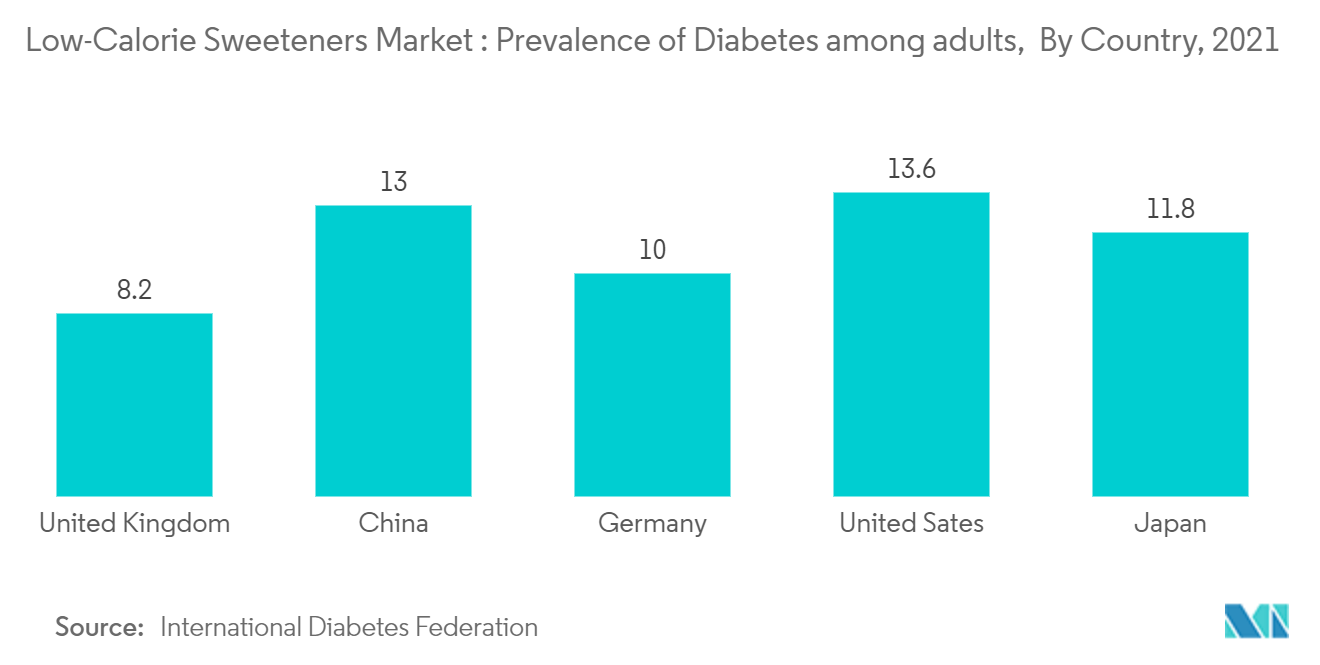
Europe is the Largest Consuming Region
The European low-calorie sweeteners market accounts for a significant share across the world, owing to rising consumer awareness about natural sweeteners. Consumers in Europe are looking for healthier food and beverage options, making manufacturers focus on adopting natural and nutritious ingredients. Consumption of stevia is rising in Europe, with countries like France, Germany, and Italy importing large amounts of stevia from developing nations. Presently, there are 11 low-calorie sweeteners approved for use in soft drinks in Europe, including Acesulfame K, Aspartame, Stevia, and Sucralose. Post government authorization, these low-calorie sweeteners are widely used in the production of soft drinks. The European soft drink industry has long been involved in a continuous process of removing added sugar from its products and introducing low or zero calories varieties on the market, thus driving the application in the beverage sector.
The European Regulatory Authority is playing a crucial role in boosting the demand for low-calorie sweeteners with stevia approved by the European Union for the use and sale of steviol glycosides extracted from the leaves of the stevia plant as a sweetener. In Europe, the regulatory bodies provide provisions for the growth of the market, thus aiding the local players to enter the market. However, the stringent and changing regulations in Europe may also hamper the market growth in the forecast period.
Low-Calorie Sweeteners Industry Overview
The low-calorie sweeteners market is concentrated with a large number of players, including large-scale manufacturers that operate in multiple regions, regional-level players, and local players that offer a wide range of low-calorie sweeteners. These players are using various strategies to expand their market share to maintain a leading position in their respective market space. Some of the key players in the low-calorie sweeteners market include Cargill Incorporated, Archer Daniels Midland Company, Ajinomoto Co. Inc., Ingredion, DSM, and Heartland Food Products Group LLC. These companies offer a wide range of low-calorie sweeteners for various applications. These players have a significant share in the low-calorie sweeteners market and growing their market share through product innovation, sustainability, catering to consumer demands, partnerships, mergers, and acquisitions.
Low-Calorie Sweeteners Market Leaders
-
Cargill Incorporated
-
Archer Daniels Midland Company
-
Ajinomoto Co., Inc.
-
Ingredion
-
DSM
- *Disclaimer: Major Players sorted in no particular order
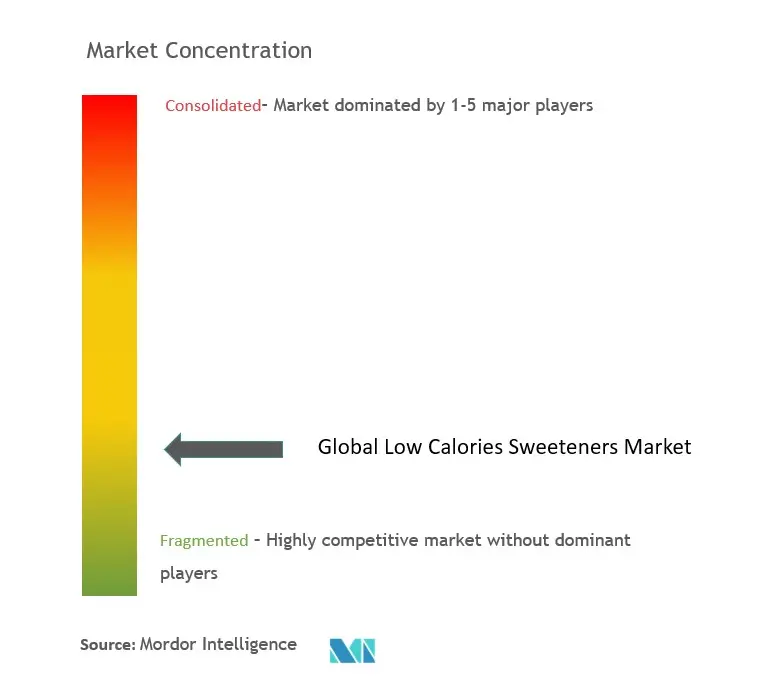
Low-Calorie Sweeteners Market News
- Jul 2022: Sweegen launched Bestevia LQ, a collection of liquid stevia-based sweeteners, at IFT FIRST, the Institute of Food Technologists' convention and exposition that took place during July 10-13 in Chicago. The sweeteners are intended to lower the amount of sugar in products, including concentrated fruit/flavored syrup, confectionary, liquid sweeteners, dessert toppings, and carbonated soft beverages.
- Mar 2022: Cargill announced its strategy of sweetening its stevia products with the commercial availability of its flagship stevia sweetener technology, EverSweet + ClearFlo. The company's sweeteners can now be blended with other all-natural tastes. This mixture can provide flavor alteration, better solubility, formulation stability, and quicker dissolving.
- Sept 2021: Ingredion Incorporated and S&W Seed Company entered the United States exclusive stevia pilot production supply agreement. According to this agreement, S&W Seed Company would leverage its proprietary stevia plant portfolio and production techniques to supply Ingredion and its PureCircle by Ingredion group of companies with United States stevia plants.
- Apr 2021: Manus Bio Inc. (Manus Bio), one of the leading US manufacturers of sustainable natural ingredients, launched NutraSweet Natural™, a plant-based sweetener with zero calories and high sweeteners.
Low-Calorie Sweeteners Industry Segmentation
Low-calorie sweeteners are sugar substitutes that have low-calorie levels and do not raise blood glucose levels. They can be consumed by consumers looking to reduce their sugar consumption. The global low-calorie sweeteners market (henceforth referred to as the market studied) is segmented by source, product type, application, and geography. By source, the market is segmented into natural and synthetic.
The Low-calorie Sweeteners Market is segmented by Source (Natural and Synthetic), Type (Sucralose, Saccharin, Aspartame, Neotame, Advantam, Acesulfame Potassium, Stevia, and Other Types), Applications (Foods, Beverages, Pharmaceuticals, and Other Applications), and Geography (North America, Europe, Asia-Pacific, South America, and Middle-East and Africa). The report offers market size and forecasts in value (USD million) for the above segments.
| By Source | Natural | ||
| Synthetic | |||
| By Type | Sucralose | ||
| Saccharin | |||
| Aspartame | |||
| Neotame | |||
| Advantam | |||
| Acesulfame Potassium | |||
| Stevia | |||
| Other Types | |||
| By Application | Foods | Bakery | |
| Frozen Food and Dairy | |||
| Confectionery | |||
| Other Applications | |||
| Beverages | |||
| Pharmaceuticals | |||
| Other Beverages | |||
| By Geography | North America | United States | |
| Canada | |||
| Mexico | |||
| Rest of North America | |||
| Europe | United Kingdom | ||
| Germany | |||
| Spain | |||
| France | |||
| Italy | |||
| Russia | |||
| Rest of Europe | |||
| Asia-Pacific | China | ||
| Japan | |||
| India | |||
| Australia | |||
| Rest of Asia-Pacific | |||
| South America | Brazil | ||
| Argentina | |||
| Rest of South America | |||
| Middle-East and Africa | Saudi Arabia | ||
| South Africa | |||
| Rest of Middle-East and Africa | |||
Low-Calorie Sweeteners Market Research FAQs
What is the current Low-Calorie Sweeteners Market size?
The Low-Calorie Sweeteners Market is projected to register a CAGR of 6% during the forecast period (2025-2030)
Who are the key players in Low-Calorie Sweeteners Market?
Cargill Incorporated, Archer Daniels Midland Company, Ajinomoto Co., Inc., Ingredion and DSM are the major companies operating in the Low-Calorie Sweeteners Market.
Which is the fastest growing region in Low-Calorie Sweeteners Market?
Asia-Pacific is estimated to grow at the highest CAGR over the forecast period (2025-2030).
Which region has the biggest share in Low-Calorie Sweeteners Market?
In 2025, the Europe accounts for the largest market share in Low-Calorie Sweeteners Market.
What years does this Low-Calorie Sweeteners Market cover?
The report covers the Low-Calorie Sweeteners Market historical market size for years: 2019, 2020, 2021, 2022, 2023 and 2024. The report also forecasts the Low-Calorie Sweeteners Market size for years: 2025, 2026, 2027, 2028, 2029 and 2030.
Our Best Selling Reports
Low-Calorie Sweeteners Industry Report
Statistics for the 2025 Low-Calorie Sweeteners market share, size and revenue growth rate, created by Mordor Intelligence™ Industry Reports. Low-Calorie Sweeteners analysis includes a market forecast outlook for 2025 to 2030 and historical overview. Get a sample of this industry analysis as a free report PDF download.



